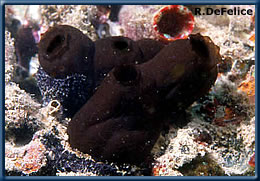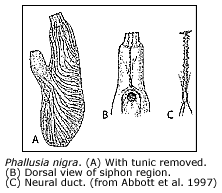

Ascidia sydneiensis

Phallusia nigra

Diademnum sp.
Phallusia nigra
 Black
sea squirt
Black
sea squirt
Phylum Chordata
Subphylum Urochordata
Class Ascidiacea
Order Enterogona
Family Ascidiidae
Description
This common large solitary ascidian is typically a velvety black or dark
brown. Small specimens or individuals growing in shaded areas may be a
translucent gray with scattered spots of blank pigment. P. nigra adheres
to the substrate by it's posterior left region. It's right has a thick,
cartilagenous, smooth tunic with prominent blood vessels. The siphons
are separated by a third to half the body length. Removing the tunic reveals
evenly distributed musculature on the right mantle. A large individual
will have around 50 oral tentacles (from Abbott et al. 1997).
 Habitat
Habitat
Common in harbors and embayments, P. nigra
lives in shallow water attached to any available hard substrate such as
dead coral, pier pilings, or floats.
Distribution
Hawaiian Islands
Throughout the main islands, primarily in harbors.
Native Range
Tropical western Atlantic
Present Distribution
Tropical western Atlantic, Mediterranean, Indian Ocean, Micronesia, and
Hawaiian Islands
Mechanism of Introduction
Unintentional, as fouling on ships' hulls
Impact
Fouling organism. Ecological impact unstudied, probably competes for space
with other fouling and shallow-water invertebrates.
Ecology
Reproduction
This species is hermaphrodite, with a simple reproductive system. Fertilization
is external, and after a time in the plankton the free-swimming tadpole
larvae will settle and metamorphose.
Feeding
Ascidians are suspension feeders that use a mucous net to filter plankton
from the water. Ciliary action moves water into the oral siphon and to
the pharynx which resembles a basket. As water is pumped through slits
in the pharyngeal basket, out the atrial siphon, it passes through a layer
of mucous coating the inside. When the mucous sheet is clogged with food,
special structures pass it to a short esophagus and into the stomach.
Remarks
The first records of this common large (to 9 - 10 cm) dark solitary ascidian,
appear to date from 1968-1972, with the report of "Ascidia
melanostoma" from fouling panels off of Oahu at 15 meters
depth and in Pearl Harbor at 9 meters by Long (1974); Abbott et al. (1997)
consider it probable that these records represent morphological variants
of P. nigra (Ascidia
melanostoma being otherwise unknown from the Islands).
Abbott et al. (1997) noted that P. nigra
"lives on rocks and dead coral on barely subtidal mudflats in Kaneohe
Bay and on floats and pilings there and in Pearl Harbor and in the Keehi
boat harbor". They further note that the color of P.
nigra, while a consistent velvety black in the tropical western
Atlantic Ocean, varies in the Hawaiian Islands, with individuals in shady
places having translucent gray tunics.
The origin of Phallusia nigra is unclear;
it may be native to the Red Sea (its type locality) and the Indian Ocean
area, or to the tropical western Atlantic Ocean, where it occurs from
Florida to Brazil (Abbott et al., 1997). It also occurs in Micronesia.
Earlier records from Australia are now referred to other Phallusia
species
References
Abbott, D.P., A.T. Newberry, and K.M. Morris. 1997. Section 6B: Ascidians
(Urochordata). Reef and Shore Fauna of Hawaii. Bishop Museum Special Publ.
64 (6B).
Long, E.R. 1974. Marine fouling studies off Oahu, Hawaii. Veliger. 17:
23-39.
© 2002 Hawaii Biological Survey, Bishop Museum
contact